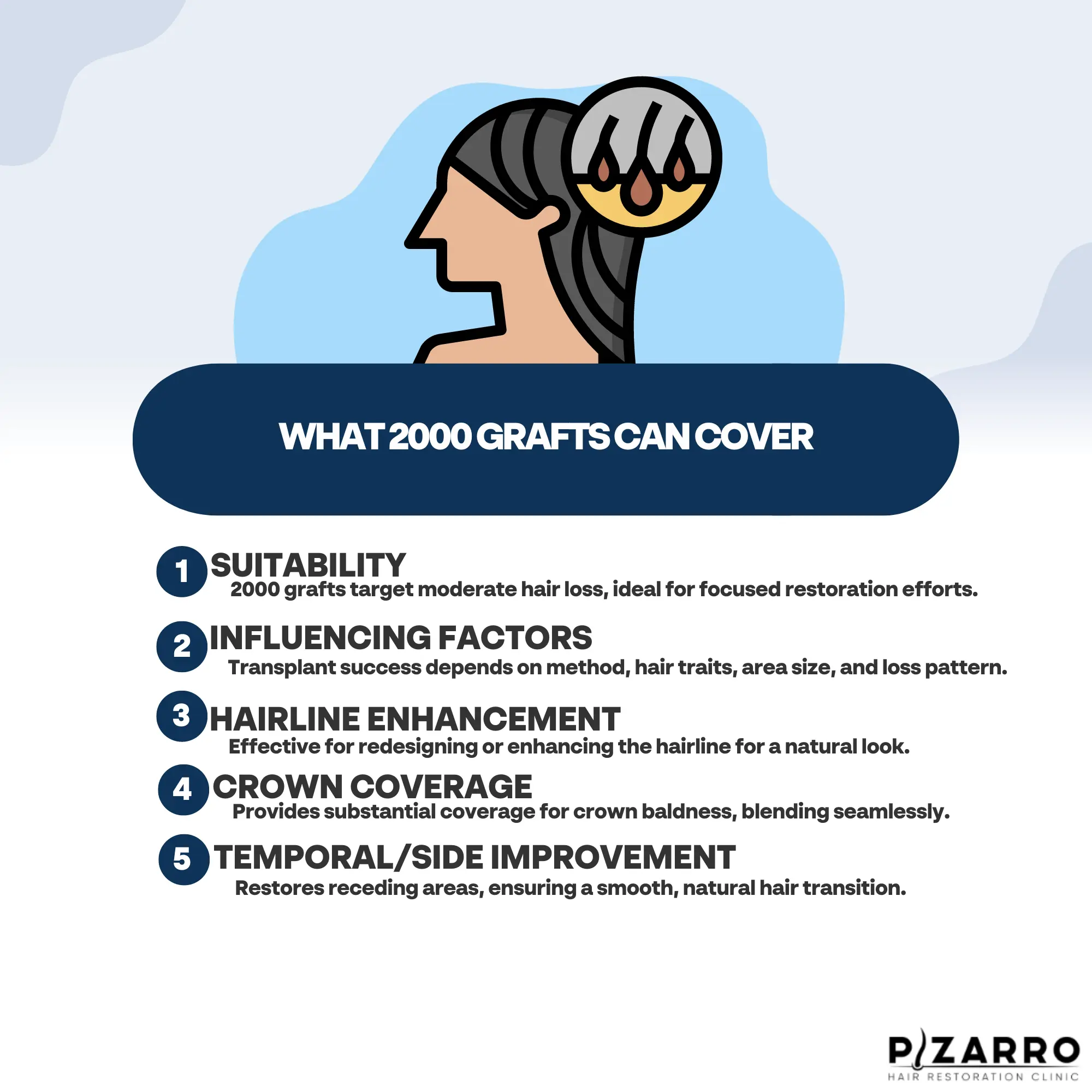Experiencing hair loss can be distressing, but thanks to advancements in hair restoration techniques, effective solutions are now available to address this concern. One such solution is a hair transplant, a procedure that involves the transfer of hair follicles from a donor site to a recipient area.
This article will explore the specifics of a hair transplant and focus on the coverage provided by 2000 grafts. Understanding what this number of grafts can achieve will give you a clearer picture of what to expect from a hair restoration procedure.
What is a hair transplant?
A hair transplant is a surgical procedure that addresses hair loss and promotes hair regrowth through a surgical procedure extracting healthy hair follicles from a donor site. This is typically the back or sides of the head, and implanted into balding areas.
The two primary methods of hair transplantation are follicular unit transplantation (FUT) and follicular unit extraction (FUE). A strip of scalp from the donor area is removed for FUT. This is then dissected to make individual grafts. In contrast, FUE involves extracting hair follicles directly from the donor site.
Hair transplant is done either via follicular unit extraction (FUE) or follicular unit transplantation (FUT). FUE extracts hair follicles directly from the donor site.
Once the grafts are prepared, the surgeon creates tiny incisions in the recipient area and carefully places each graft to achieve natural-looking hair growth. The transplanted hair then follows the natural hair growth cycle and regrows in the new location within a few months.
What are grafts in a hair transplant?
Grafts in a hair transplant refer to the hair follicles extracted from the donor site and transplanted to the recipient area. These follicles can contain one to four hairs, and the choice of graft type depends on the desired outcome and the characteristics of the patient’s hair.
The number of grafts required in a hair transplant varies based on the extent of hair loss, the desired hair density, and the characteristics of the donor’s hair. More significant hair loss will typically require more grafts to achieve satisfactory coverage.
Understanding 2000 grafts in a hair transplant
If you want to know how much area does 2000 grafts cover, basically, a hair transplant using 2000 grafts is considered a medium-sized procedure. It can provide substantial coverage for individuals with moderate hair loss or those looking to restore hair in specific areas.
The coverage achieved by 2000 grafts can vary depending on several factors, including:
1. Method of transplantation
The transplantation method plays a role in determining the coverage achieved by 2000 grafts. FUT, which provides a higher yield of grafts, can cover a slightly larger area than FUE at the exact graft count.
2. Hair characteristics
The characteristics of the patient’s hair, such as color, texture, and curliness, can impact the coverage achieved by 2000 grafts. Individuals with thick hair may achieve more coverage than those with fine hair, as the former provides a fuller appearance.
3. Size of the recipient area
The size of the recipient area also influences the coverage achieved by 2000 grafts. Suppose the balding or thinning area is more extensive. In that case, the grafts may need to be strategically placed to ensure the most effective coverage.
4. Hair loss pattern
The pattern of hair loss plays a role in determining the coverage achieved by 2000 grafts. Suppose the hair loss is concentrated in specific areas, such as the hairline or crown. In that case, the grafts can be focused there, potentially achieving a more noticeable improvement.
What can 2000 grafts cover?

The coverage provided by 2000 grafts can encompass different areas of the scalp, depending on the individual’s specific needs. Here are some examples of what 2000 grafts can cover:
1. Hairline restoration
If you want to restore your hairline, 2000 grafts can achieve significant coverage, creating a natural-looking frame for your face. The surgeon will strategically design the new hairline to complement your facial features and implant the grafts precisely.
2. Crown restoration
For individuals with baldness at the crown, 2000 grafts can provide coverage, reducing the visibility of the exposed scalp. The surgeon will carefully place the grafts to look like a natural hair growth pattern, blending it seamlessly with existing hair.
3. Temporal and side restoration
2000 grafts can effectively restore hair in the temporal and side areas, addressing receding hairline and temple hair loss. The surgeon will artfully implant the grafts to create a natural-looking transition between the transplanted and existing hair.
4. Scar concealment
If you have a noticeable scar on your scalp, 2000 grafts can be used to conceal it by transplanting hair directly into the scar tissue. The surgeon will carefully place the grafts to ensure optimal coverage, minimizing the visibility of the scar.
Takeaway
A hair transplant using 2000 grafts can achieve significant coverage, restoring hair in various areas of the scalp. The specific coverage will depend on the transplantation method, hair characteristics, recipient area size, and hair loss pattern.
To determine the most suitable hair restoration approach for your needs, it’s essential to consult with an experienced hair transplant surgeon. They can evaluate your hair loss condition, discuss your goals, and recommend the optimal number of grafts to achieve the desired results.
Get premium hair restoration in Orlando, Florida
Are you searching for a reliable hair restoration in Orlando, Florida? Look no further than Pizarro Hair Restoration! For top-notch and exceptional results, our professional team is at your service. Schedule your consultation today!






